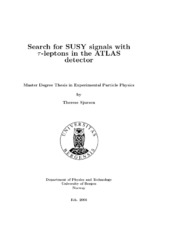Search for SUSY signals with tau leptons in the ATLAS detector
Abstract
The main topic of this thesis is the study of the discovery potential of the ATLAS detector for SUSY, by considering a supersymmetric decay chain involving two tau leptons. In supersymmetric models where R-parity is conserved, the lightest supersymmetric particle (LSP) is stable. This makes the LSP a natural candidate for dark matter if it is electrically neutral. Thus, in this case the LSP will escape detection, complicating the task of determining sparticle masses. The end-point of the invariant mass distributions of the visible particles in the decay chain will contain information on the masses of the supersymmetric particles involved in the decay chain. We have investigated the end-point of the invariant mass distribution of the two taus originating from the process: neutralinoTwo -> tau + stau -> tau + tau + neutralinoOne, in one benchmark point. Here, neutralinoOne the LSP and the benchmark point under consideration lies in the coannihilation region within the mSUGRA parameter space. This is done with the full simulation of the ATLAS detector, and an inclusive and detailed study of background rejection has been performed. Due to their short life time, tau leptons can not be detected directly in the ATLAS detector, thus making physics analysis with taus complicated. The tau reconstruction algorithms in ATLAS reconstruct taus from their visible hadronic decay products. The main diffculty in this task is distinguishing these so-called tau-jets from jets originating from QCD processes. In this analysis, we have therefore focused on single-prong taus, since this minimises the contributions from fake reconstructed taus. The main topic of this thesis is the study of the discovery potential of the ATLAS detector for SUSY, by considering a supersymmetric decay chain involving two tau leptons. In supersymmetric models where R-parity is conserved, the lightest supersymmetric particle (LSP) is stable. This makes the LSP a natural candidate for dark matter if it is electrically neutral. Thus, in this case the LSP will escape detection, complicating the task of determining sparticle masses. The end-point of the invariant mass distributions of the visible particles in the decay chain will contain information on the masses of the supersymmetric particles involved in the decay chain. We have investigated the end-point of the invariant mass distribution of the two taus originating from the process: neutralinoTwo -> tau + stau -> tau + tau + neutralinoOne, in one benchmark point. Here, neutralinoOne the LSP and the benchmark point under consideration lies in the coannihilation region within the mSUGRA parameter space. This is done with the full simulation of the ATLAS detector, and an inclusive and detailed study of background rejection has been performed. Due to their short life time, tau leptons can not be detected directly in the ATLAS detector, thus making physics analysis with taus complicated. The tau reconstruction algorithms in ATLAS reconstruct taus from their visible hadronic decay products. The main diffculty in this task is distinguishing these so-called tau-jets from jets originating from QCD processes. In this analysis, we have therefore focused on single-prong taus, since this minimises the contributions from fake reconstructed taus.
